Page Contents
The world-famous American city of Chicago is located in north-eastern Illinois on the south-western shores of Lake Michigan. It is the third largest city in the USA by population, after New York City and Los Angeles; the city itself being home to 2.7 million people and 9.5 million people in the metropolitan area. The purpose of the visit featured on this webpage was to learn a little about what made this city so great and to look at some of the city’s architecture; in terms of having an interest in industrial and modern architecture, Chicago is a must-visit destination. Featured here is a brief description of the city, followed by some of its history, a selection of the main sites of interest to the visitor, a look at skyscrapers noted during the trip and some other nearby attractions.
Above: Chicago, birthplace of the skyscraper; skyline view with the Buckingham Fountain in the foreground. Dedicated in 1927, the fountain is one of the largest in the world and is a landmark in the centre of the city’s Grant Park.
Chicago forms the major industrial, commercial, cultural and shipping centre of the Midwest. Trading and transportation links came about with the construction of the Erie Canal and railways, and the prairies were opened up, attracting settlers and industry to the area. The city became a noted cultural centre in the late 19th- and early 20th-centuries with the establishment of the Chicago Symphony Orchestra in 1891. It also achieved notoriety in the 1920’s as the home of gangsters, in particular Al Capone. Chicago has many colleges and universities, one of the largest rail terminals in the world, and its O'Hare International Airport is amongst the list of busiest airports in the world. The city’s primary industries have historically been steel, chemicals, machinery, food processing, and metal working, as well as tourism. As well as Al Capone, Chicago has had or has many other famous residents, including Ernest Hemmingway, Hugh Hefner, Oprah Winfrey and Barack Obama.
Above: “Flamingo”, a 53-foot (16m) tall free-standing abstract sculpture located in Federal Plaza in front of the Kluczynski Federal Building. It was created by noted American artist Alexander Calder and unveiled in 1974 (although was constructed in 1973).
Some Key Events in Chicago’s History
In the late 1700’s, the site where Chicago stands was a trading post and then it became Fort Dearborn military post (1803). The 1832 Black Hawk War ended the last Native American resistance in the area and Chicago was incorporated as a town in 1833 and as a city in 1837. The city was virtually destroyed in the Great Chicago Fire of 1871. Over 250 people died and 17,000 buildings destroyed in a tragedy allegedly started by a cow kicking over a lantern. The destruction caused by the city’s historic fire set in motion a building boom that has never really ended. 1885 saw the construction of the first skyscraper, the Home Insurance Building; more on this in the section below entitled “Skyscrapers”. The following year, in May 1886, the Haymarket Affair (also known as the Haymarket Riot, or Haymarket Massacre) took place; a labour protest about hours and conditions ended in a bomb exploding at Haymarket Square, killing seven policemen and two bystanders. Eight anarchists were convicted of murder, with three being later pardoned due to lack of evidence. The site of the original Haymarket Square Public Marketplace is located about half a mile west of Chicago’s Loop (see next section). Today, no original structures exist here from the time of the Haymarket era. Amongst the offices, industrial lofts and parking lots may be found the base of a monument dedicated to the policemen who died and this stands at the northeast corner of Randolph Street and the Kennedy Expressway. More on the Atlas Obscura Website Here.
Above: Fully zoomable map of Chicago, centred on The Loop community area, described further down the page (map courtesy of openstreetmap.org)
The city hosted the World’s Fair Columbian Exposition in 1893 and the site included Daniel Burnham’s “White City”. The only building left from this today serves as the Museum of Science and Industry. This building was originally built in 1893 as the Palace of Fine Arts at the Columbian Exposition of 1893 and was designed in the Neo-Classical style by Charles B. Atwood and reconstructed between 1929 and 1940; it opened as a museum in 1933 and this must-see attraction apparently takes a day just to see the main attractions, over its almost twenty acres of floor space. The nearby Midway Plaisance, at 600 feet wide and a mile long, was also originally part of the exposition and now serves as a park area. Just prior to the exposition, in 1892, Chicago saw the construction of its first elevated train. The initial 3.6-mile (5.8km) track was extended to Jackson Park near the exposition site, in time for visitors to the great event of 1893.
Above: The Chicago River is 156 miles (251km) long and has a record-breaking 43 opening bridges. In 1900, an engineering project resulted in the reversal of the river flow, for reasons of not contamination drinking water drawn from Lake Michigan with wastewater. The main branch of the river is famously dyed green every St Patrick’s Day.
1919 was the year of the city’s Black Sox Scandal. This was a Major League Baseball match fixing incident in which eight members of the Chicago White Sox were accused of deliberately losing the 1919 World Series against the Cincinnati Reds in exchange for money. The eight players were banned from baseball for life and became known unofficially as the “Black Sox”. The result of this scandal was the appointment of the first Commissioner of Baseball, a position of absolute power created in order to restore the sport’s integrity. In 1929, another, and perhaps more internationally famous incident took place in Chicago’s history, namely the Saint Valentine's Day Massacre. The event concerned the murder of seven bootleggers of the “Bugs” Moran gang by members of Al Capone’s gang disguised as policemen on 14th February. The murders were part of Capone’s attempts to monopolise the illegal traffic in liquor in the era of prohibition. As Chicago grew steadily since the earlier days of the 20th century, the phrase “Chicago-style politics” came to be used nationwide, referring to the city and regarding its hard-hitting sometimes corrupt politics. Historically, it has had one of the most segregated communities in the United States and today the expanse of neighbourhoods of varying ethnicities. The city comprises three areas – the North Side, West Side and South Side, with the latter being the larger of the three. Although there have been improvements in more recent times, many neighbourhoods on the South Side still have high levels of poverty, lack educational resources and are infested with street gangs. However, visitors to the city are rarely affected by violent crime with most of the areas of interest being friendly and safe places to go to; as with any large city, sensible precautions should be taken to reduce the risk of being a victim of crime of any sort.
 |
Above: Left - Henry Moore’s “Nuclear Energy” (1967) stands near the site
where Enrico Fermi and his colleagues made history on the University of
Chicago campus, by achieving the first controlled generation of nuclear
power on December 2nd 1942. This started off an era of not only
understanding how to capture nuclear power for the generation of
electricity, but how to build an atomic bomb.
Right – In 1955, the first
McDonald’s franchise opened in Des Plaines, 17 miles (27km) northwest of
downtown Chicago. Ray Krok, a milkshake mixer salesman, convinced Dick
and Mac McDonald to franchise their burger stand in San Bernardino,
California. The rest, as they say, is history.
Other places of historic interest in the city include the Chicago Water Tower (see lower down the page) and Hull-House (probably the most renowned complexes of American social settlement houses and located at the corner of Polk and Halsted Streets on the campus of the University of Illinois at Chicago). 15 miles (24km) south-southeast of Chicago’s Loop (see next section) is located Pullman National Monument. This ½-mile-squared residential neighbourhood was originally a company town built by and for the Pullman Car Company from 1880 to 1888 (some of the structures which were originally part of the company town are located outside of this landmark district’s borders. The planned industrial town had apartments, shops, a hospital and a hotel, but the project failed after a strike in 1894, when a lowering of wages made rents too expensive for the workers.
Above: Iconic Symbols – The sign of the Beaux-Arts-style Chicago Theatre (left). The theatre was built in 1921 as a movie theatre and today serves as a performance venue. The ‘Route 66 Begin’ sign (right) is on East Adams Street, where the street intersects with South Michigan Avenue. Here is the traditional beginning of the infamous road which runs 2,448 miles (3,940km) westwards (or ends, if travelling eastwards). It is also known as the Will Rogers Highway, the Main Street of America or the Mother Road. One of the original highways in the U.S. Highway System, it runs between Chicago and ends on the shores of the Pacific Ocean in Santa Monica. The original Route 66 Chicago end was at Lake Shore Drive, by the shores of Lake Michigan. Due to one-way systems, Route 66 running in the opposite direction from Santa Monica meets South Michigan Avenue from Jackson Boulevard, one block south of Adams Street.
The Loop community area is home to the city’s central business district. It is bounded to the north and west by the Chicago River, to the east by Lake Michigan and to the south, by Roosevelt Road. In 1803, the US Army erected Fort Dearborn – the first settlement in the area sponsored by the fledgling nation. The location of this fort was in what is now The Loop area, on the south bank of the Chicago River, near today's Michigan Avenue Bridge. There are no traces of the fort remaining, although its location is still commemorated in the form of plaques marking its position. Around the turn of the 20th century, a prominent elevated railway encircling the downtown area was built to help alleviate issues of overcrowding in the streets below. The railway, along with the cable car turning loops, are thought to have given this area its name. This area forms the Chicago’s financial and governmental hub and is where some of the world's earliest skyscrapers were constructed. In 1908, the city’s addresses were made uniform by naming the intersection of State Street and Madison Street as the origin of the Chicago street grid, thus acknowledging the Loop’s position as the city’s central area.
Above: A system of elevated trains came about after the 1871 Great Chicago Fire when the city was rebuilt. As the city developed, within a matter of decades, its streets could no longer handle the numbers of people, streetcars and horses, thus requiring a solution – elevated trains on what was originally known as the Union Loop. Today, there are four lines of the Chicago rapid-transit system (or the "L") encircling the business district.
The Loop is the second largest commercial business district in the United States after Midtown Manhattan in New York City. Here are to be found the headquarters of many local, national and international businesses, as well as many of the city’s most well-known attractions. Whilst during the week, there are plenty of business people going about their daily business, the area is transformed at weekends when people take to State Street, known for its shopping, history, architecture, education, theatre and restaurants.
Above: Just south of Millennium Park in The Loop area is located The Art Institute of Chicago. One of the city’s main highlights, it is the Midwest’s largest art museum, housed inside an impressive Beaux-Arts building which includes a modern wing by Italian architect Renzo Piano. The collection has some 260,000 items from around the world spanning over 4,000 years and is noted for its Impressionist and Post-Impressionist works.
To list all of the sights in this area of the city would be far beyond
the scope of this webpage, but some of the highlights also include the
Chicago Cultural Center (a Beaux-Arts palace with some spectacular
interior decoration, built in 1897 as the city’s first main library and
now housing a visitors information centre, mainly temporary exhibitions
of contemporary art and performance spaces), the Chicago Board of Trade
Building, the Willis Tower (see further down the page), The Rookery (an
1888 landmark 11-storey building considered a precursor to modern
skyscrapers), the Harold Washington Library Center (America’s largest
public library building), the Jewelers’ Building (a 522-foot/159m Beaux
Arts terra-cotta building dating completed in 1927), Millennium and
Grant Parks (more about the former lower down the page; the adjoining
Grant Park is home to The Art Institute of Chicago, the Museum Campus,
the Buckingham Fountain and also hosts festivals in the summer), the
Chicago Riverwalk (running along the south bank of the river, beginning
near Lake Michigan, this walkway passes under bridges and offers great
place to take a leisurely stroll, cycling, eating or taking to the river
on a rented boat or kayak), the massive 13-storey Marshall Field and
Company Building (built 1891-92, the third largest store in the world
and home to ‘Macy's at State Street’ since 2006), the Monadnock Building
(an office block dubbed “the last of the big masonry towers”), the
Schlesinger-Mayer Store by architect Louis H. Sullivan (later known as
the Carson, Pirie, Scott and Company Building and now known as the
Sullivan Center; part of the Loop Retail Historic District, it was built
as a department store in three phases and is now a Chicago landmark), 55
West Monroe (Originally named the Xerox Center, a 41-storey tower
expressive of the 1970s “Silvers”; its smooth glass curtain walls and
rounded edges providing an anchor along both adjacent streets on a
corner-site), Columbia College Chicago, theatres (including the Chicago,
the Auditorium, the Cadillac Palace and the Goodman Theatres), the
Chicago Symphony Orchestra, the Lyric Opera of Chicago, the Joffrey
Ballet, the Museum of Contemporary Photography, the Historic Route 66
Begin Sign (shown and described further up this page), and the Chicago
Architecture Center (see further down this page).
A thumbnail photo
gallery which includes photographs taken from The Loop area, as well as
other central areas of the city follows further down the page (under the
heading ‘General Photographs from the Visit’), as does a section on some
of the more well-known skyscrapers.
Upon arrival in Chicago’s downtown area, the first place of interest visited on this trip was the James R. Thompson Center. Located at 100 W. Randolph Street in the Loop district of Chicago, it opened in 1985 as the State of Illinois Center and was renamed in 1993 to honour former Illinois Republican Governor James R. Thompson who commissioned it; the building is often referred to by either of these two names, and also the “State of Illinois Building”. The purpose of the visit here was to take a look at its vast atrium, first noted by the author on a book on modern architecture some months earlier.
 |
Above: Exterior and Interior of the James R. Thompson Center (interior photo is a perspective composite image)
The James R. Thompson Center stands on a city block with a masonry wall defining the site line of the 1920’s Sherman Hotel which formerly stood here. The steel-and-glass curved structure has sky-blue, red and salmon-coloured glazing at the lower levels and up and down the interior, reminiscent of car design from the 1950’s. It has a convex glazed plaza entrance and a public-access 17-storey central atrium which measures 308 feet (94m) high by 160 feet (49m) across. The floors are accessed by freestanding lifts and staircases cantilevered out from the sides of the atrium’s interior. This vast impressive space is surrounded by open offices and retail outlets at the lower levels and was intended to relate to capitol buildings, with their centrally planned domed layout, whilst representing the openness of government. The ground floor has a granite and marble pattern – a nod to earlier domed state buildings. Construction of the building, designed by architect Helmut Jahn, was not without controversy; it was built with taxpayers’ money ($173 million) using South African steel during a time when steel mills in the region were closing and there were other issues, such as with the heating and cooling in the workspaces which were surrounded by glazing. Problems aside, it has been given various descriptive names, such as ‘Chicago’s Eyeful Tower’, ‘Taj Mahal’, ‘Starship Chicago’ and the ever-so-slightly cynical ‘Thompson’s Folly’.
Chicago’s Navy Pier sits on the shoreline of Lake Michigan and with nearly two million visitors each year, is Chicago's number one tourist attraction. The 3,300 foot (1,010m) long pier is located in the Streeterville neighbourhood of the Near North Side community area. Originally completed in 1916 as part of Daniel Burnham's plan for Chicago, it was used as a military and freight terminal and subsequently became an uninspiring slab of concrete, until a huge drive to attract visitors resulted in the installation of a variety of attractions. Here, on its waterfront location, Navy Pier reopened in 1995 and also underwent extensive renovations for its centenary in 2016. Today, its fifty-plus acres includes parks, gardens, shops, restaurants (the New Food Experience is the pier’s revamped foodcourt), family attractions (including an IMAX® theatre, rides including the 196 foot (160m) high Centennial Wheel, the Wave Swinger and the Musical Carousel, the Amazing Chicago’s Funhouse Maze, and the Chicago Children’s Museum), the Chicago Shakespeare Theatre and also exhibition facilities. At the pier’s shore end is Polk Bros Park, which contains a fountain comprised of about 250 programmable jets. In the winter, the park is used as an ice rink. As well as all of the attractions on offer on Navy Pier, it makes for an excellent walk away from the busy streets and offers excellent views of the city skyline, albeit in two halves whist strolling along its walkways. Some photographs taken from a walk along the entire length of the pier are shown in the thumbnail gallery below (click on an image to enlarge):
The Magnificent Mile (or Mag Mile for short) runs along North Michigan Avenue, north of the Chicago River and was connected to the city, as it expanded northwards, by the North Michigan Avenue bascule bridge (1920). The bridge was the first of its kind in the world and provided a gateway to what is Chicago’s main shopping and most fashionable street. Along the Magnificent Mile is an impressive array of skyscrapers, historic buildings and retail outlets and this term to describe this approximately 1 mile (1.6km) strip was coined by a developer in 1947, sticking ever since. Department stores and boutiques along here include Neiman Marcus and Tiffany & Co. respectively, as well as recognisable chain stores. This section of the avenue is popular at Christmastime, when the illuminated decorations brighten up the otherwise often drab December days.

Above: A street-view along the Magnificent Mile
Although largely destroyed during the Great Fire of Chicago, today, notable buildings along this stretch include the John Hancock Center, the Tribune Tower and the Wrigley Building (the three of which are detailed in the ‘Skyscrapers’ section lower down the page), the Gothic Revival-style Fourth Presbyterian Church, the Hotel InterContinental (Originally built in 1929 and boasting a range of elaborate architectural styles in its public spaces), The Drake Hotel, Oak Street (a lane lined with very upmarket boutiques found where the magnificent Mile ends), the Museum of Contemporary Art Chicago (off Michigan Avenue), Water Tower Place (a shopping complex and theatre; one of the world’s tallest reinforced concrete buildings) and the Chicago Water Works & Pumping Station (see next section).
Chicago Water Works and Pumping Station
Towards the northern end of the Magnificent Mile are sited two historic castle-like structures, namely the Water Tower and the Pumping Station. Designed by architect W. W. Boyington and completed in 1869, the crenulated Gothic-Revival water works was modelled after a medieval castle and these two structures are among only a few to survive the Great Chicago Fire of 1871. Listed on the National Register of Historic Places, the tower housed the 138-foot (42m) stand pipe which was needed for the adjacent pumping station. It is no longer in use as part of the city’s water works and today is home to a theatre and the Chicago Office of Tourism art gallery (known as the City Gallery), which showcases the work of local photographers and artists. The pumping station still functions as part of the city’s water supply system and also houses a visitor information centre and a café.
Bordered by Michigan Avenue, Columbus Drive, and Randolph and Monroe Streets, the award-winning 24.5-acre (10ha) Millennium Park opened in 2004. This highly ambitious renovation project was laid out on former railroad property and is a showcase for public art, music, architecture and landscape design, overshadowing its older southern neighbour, Grant Park.
Above: The Cloud Gate sculpture in Millennium Park is sometimes referred to by its nickname “The Bean”, due to its resemblance to a giant reflective kidney bean. Designed by British-based sculptor Anish Kapoor, it is a popular place for visitors to take photographs of themselves with the surrounding Chicago skyline in the background.
The centrepiece of Millennium Park is the Cloud Gate sculpture (see
above), an inspiring, seamless, stainless steel installation which was
inspired by liquid mercury. Visitors here marvel at its beauty and the
reflections of both city and sky, as they wander not only around, but
underneath this inspiring work. Another piece of public-art which draws
visitors in is Crown Fountain by Spanish artist Jaume Plensa. It
comprises two opposing 50-foot (15¼m) glass-brick towers set either side
of a black granite plaza. Video images of the faces of 1,000 Chicagoans
play on the facing towers and these form the interactive Crown Fountain,
as water sprouts out of them, landing in a shallow reflecting pool on
the granite plaza; the fountain is a popular place for families and
those wishing to cool off during the warm summer months. Towards the
north east of the park may be found the Jay Pritzker Pavilion, an
open-air auditorium designed by American-Canadian architect Frank Gehry.
The pavilion has an eye-catching roof comprising large curling
stainless-steel ribbons that loom 120 feet (37m) high. With a design
created to improve acoustics, this venue hosts outdoor concerts
including, amongst others, the Grant Park Music Festival series of
summer concerts. Equally stunning is Gehry’s BP Bridge, where ribbon of
the same material as the pavilion forms a 925-foot (282m) long pathway
that snakes its way from here across Columbus Drive to Maggie Daley
Park. The newest addition to the waterfront, this park has, amongst
several attractions, a skating ribbon, the seasonal Millennium Park Ice
Rink, and children’s play areas. Back to Millennium Park, other
attractions here include the Millennium Monument (on the north-western
corner of the park, comprising a series of 40-foot (12m) Doric-style
columns arranged in a semi-circle, forming a limestone peristyle. A
tribute to the individual, corporate and foundation benefactors of
Millennium Park, it is a replica of an older concrete peristyle which
didn’t stand up to the lakefront weather), the Harris Theater for Music
and Dance (on the northern end of the park, adjacent to the Jay Pritzker
Pavilion; a 1,500-seat theatre and home to some 35 of Chicago’s
performing arts companies), the Lurie Garden (with its high “shoulder”
hedges that shelter a perennial garden), Park Grill (the park’s only
restaurant), and finally, the Nichols Bridgeway (a pedestrian bridge
which crosses over Monroe Street, connecting the park with the third
floor of the West Pavilion of the Modern Wing, the Art Institute of
Chicago's newest wing; the bridge was designed by Renzo Piano, the
architect of the Modern Wing).
The nearby Welcome Center (201 East
Randolph Street) is a good starting point to find out what Millennium
Park has to offer, including any events and/or tours. More photographs
of the park are shown in the thumbnail gallery below (click on an image
to enlarge):
The Chicago Architecture Center
Formerly the Chicago Architecture Foundation, the Chicago Architecture Center (CAC) is located in Mies van der Rohe's One Illinois Center at 111 E. Wacker Drive at the northern end of The Loop. Founded in 1966, the CAC is a non-profit cultural organization whose mission is to inspire people to discover why design matters. The centre has a large exhibition space, a lecture hall for conferences, and offers volunteer docent-led tours to help visitors understand and appreciate architecture downtown and in the city’s diverse neighbourhoods (there are approximately 85 different tours available). The architecture cruises on the Chicago River which are available from the CAC (April–November) are rated very highly on a national level. As well as offering an architecture and design education programme, the CAC also hosts the annual Open House Chicago over a weekend each October; this is a free event which gives the public access to many buildings and spaces in the city which would otherwise be off-limits. Some photographs taken from the CAC are shown in the thumbnail gallery below (click on an image to enlarge):
One of the highlights of the Chicago Architecture Center, on the ground level, is the Chicago Model Experience – a 3D-printed scale model of the city’s downtown area which includes over 4,200 individual buildings. The model is accompanied at set times by the ‘experience’ which includes stories told through dynamic video and light projections. Also in this gallery are displays introducing some of the main architects who help shaped the city skyline and made Chicago the ‘city of architecture’, ‘Chicago’s Building Blocks’, a look at five of the city’s neighbourhoods from an architectural perspective, a section that looks at common housing types found throughout the city, a large colour-coded wall map charting the city’s expansion, a look at how the large model on display was made and a look at current and upcoming development projects that will alter the shape of the city. Also on the ground level is the CAC Store, which offers Chicago and architecture-themed products, including books, clothing, home décor, souvenirs and knickknacks, including plenty of Frank Lloyd Wright-related items to choose from. On the Chicago Architecture Center’s upper level is housed the Usher Lambe Rotating Gallery (temporary exhibits) and the larger Drake Skyscraper Gallery. The latter, with displays and oversized architectural models of skyscrapers aplenty, includes the models themselves (gathered from around the world), a display documenting the design and construction of Dubai’s Burj Khalifa (the world’s tallest building at the time of writing), information about technological innovations that have been developed to help skyscrapers become taller than ever before, displays on award-winning tall building designs and on the history of the tallest buildings, and a display documenting Chicago’s notable architects and firms who have influenced the evolution of skyscraper design. The ‘Out of the Window’ display is just that – the view on this floor straight out towards the river and beyond where the view is a showcase of the various building styles that have shaped the city for over a century. Also on the upper level are the Arcelormittal Design Studio and the Joan & Gary Gand Lecture Hall (not part of the exhibition galleries).
General Photographs from the Visit
The thumbnail gallery below shows some of the sights seen whilst walking around the city (including some mentioned elsewhere on this webpage) and this is followed by a look at some of the key skyscrapers pertaining to this visit (click on an image to enlarge):
Chicago's architecture is famous throughout the world and one style is referred to as the Chicago School. Architects led by Louis Sullivan, whose steel-framed, multi storey buildings erected after the 1871 Chicago Fire, established the principles of skyscraper construction. Much of this early work is also known as Commercial style. The first Chicago School was a school of architects active in the city at the turn of the 20th century, whilst a second modernist Chicago School came about from the 1940’s to the 1970’s, which pioneered new building technologies and structural systems such as the tube-frame structure.
Chicago became the birthplace of the skyscraper in 1885, with construction of the Home Insurance Building. Designed by architect, Major William LeBaron Jenney and referred to as the Father of the Skyscraper”, it had 10 storeys and was 138 feet (42m) tall. Whilst this may not seem very tall by today’s standards, it was gigantic at the time. The design incorporated a steel frame that supported not only the walls but the whole of the building. The exterior was, however, made of brick. This innovative design began a new type of construction known as the “Chicago Skeleton”. Alas, the Home Insurance Building was demolished in 1931. Since that time, throughout the years, developers have continued to add to Chicago’s skyline. Whilst the term “skyscraper” simply means a very tall building of many storeys, the term has been defined in a number of ways over time, primarily focusing on a building based on a steel skeleton, as opposed to constructions of load-bearing masonry. For a more detailed explanation of the term, a link to the relevant section on Wikipedia may be found Here. Below are featured some of the skyscrapers to be seen in the city – this list is far from comprehensive and reflects those noted during the author of this page’s visit which were of particular interest (there would be many more featured here, time permitting!).
Marina City
The twin towers of Marina City are perhaps one of Chicago’s most original and photographed constructions. Designed by architect Bertrand Goldberg (1913-97), it opened between 1963 and 1967 and is considered his finest work. Seen as an early forerunner of the return of living closer to city centres, it occupies almost an entire city block in a former railroad district on the Chicago River, directly across from the Loop. The construction consists of a plinth on which are placed low commercial buildings and two round 60-storey towers of reinforced concrete. Perhaps one of the most notable features is the spiralling ramps of the car parks which occupy the lower levels of each tower. Above these rise 40 floors of balconied apartments (900 in total). On its completion, Marina City included a marina, theatre, gymnasium, skating rink, bowling alley, nightclub, restaurants and commercial space; it was designed to attract small households by functioning as a “city within a city”. Some photographs of Marina City are shown in the thumbnail gallery below (click on an image to enlarge):
John Hancock Center
Still commonly referred to as the John Hancock Center, this 100-storey, 1,128 foot (344m) super-tall skyscraper was renamed “875 North Michigan Avenue” in February, 2018; the original name referred to the original tenant of the building, the John Hancock Mutual Life Insurance Company. However, in 2018, the organisation requested that its name be removed and at the time of writing, the owner of the building is seeking another naming rights deal. Located in the Magnificent Mile district, in the heart of the city’s finest shopping and dining area, the chief designer was Bruce Graham with Fazlur Khan the structural engineer, with the construction being supervised by Skidmore, Owings and Merrill. The building has characteristic X’s on the façade, which are used as cross-braces to help it withstand the strong winds coming off Lake Michigan. When topped out in May, 1968, it was the second-tallest building in the world and the tallest outside New York City. Completed in 1969, the taller of its two distinctive antennas take the total height, including masts, to 1,500 feet (457m). The John Hancock Center was constructed for multi-purpose uses and is home to offices, restaurants and around 700 apartments. Also, the 44th floor sky lobby features the USA's highest indoor swimming pool. For the visitor, North America’s fastest lift/elevator ride takes ticket holders up to a 17,000 square-foot observation deck on the 94th floor, “360 Chicago”, for breathtaking views of the city skyline, Lake Michigan and four neighbouring states. For those brave enough, a ticket may also be purchased to include the exhilarating TILT ride – an enclosed moving platform that literally tilts the rider out and over the edge of the building at a 30° angle for dizzying down-facing views. Also on the north side of the observation deck is BAR 94, touted as the highest bar in Chicago. On the 95th floor is The Signature Room, a restaurant offering contemporary American fare where diners can also enjoy the panoramic views. Thumbnail gallery of the visit below (click on an image to enlarge):
Willis Tower (Formerly the Sears Tower)
One of the city’s iconic and best-loved buildings, the Willis Tower was built in 1973 for retailer Sears Roebuck and Co. to house thousands of office workers from buildings distributed throughout the Chicago area in a single building on the western edge of Chicago's Loop (the company has since moved out). Designed by Bruce Graham of Skidmore, Owings & Merrell, the tower is clad in bronze-tinted glass and stainless aluminium. Standing 1,450 feet (442m) tall and with 110 storeys, for many years it was the tallest building in the world (until completion of the Petronas Towers in Malaysia in 1996) and was the tallest in the United States until completion of One World Trade Center in New York City (topped out in 2013). In 1982, two television antennas were added to the tower, increasing its total height to 1,707 feet (520m). In the year 2000, the western antenna was later extended, bringing the overall height to 1,729 feet (527m). The Willis Tower was constructed at a time when the US economy was undergoing a boom with a spirit of optimism resulting in a skyscraper craze in Chicago as part of the city’s ambition to rival New York as an economic and cultural leader. It was also about this time that the John Hancock Center (see earlier) and the Aon Building (see further down) were also constructed. The tower uses nine exterior frame tubes, thus avoiding the need for interior supports. On the 103rd floor is the Skydeck, which offers visitors 360° panoramic views of the city and boasts views into four states and up to 50 miles on a clear day. Of the countless city sights which can be seen from the Skydeck (subject to weather conditions), a few highlights to look out for are the aforementioned Marina City and John Hancock Center, Soldier Field (home to the Chicago Bears football team), the Chicago River, Lake Michigan, the United Center (a vast indoor sports arena and concert venue), Grant Park, Merchandise Mart (built in the 1930’s and one of the world’s largest commercial buildings, in terms of floor area), McCormick Place (a convention centre) and Navy Pier (see further up this page). For the less feint-hearted visitor to the Willis Tower, tickets can also be purchased to include the Skydeck Ledge. The ledge comprises a series of glass boxes which extend outwards from the tower and it is possible to have the experience of being on a glass floor more than 1,353 feet (412m) above the city streets. Thumbnail gallery of the visit below (click on an image to enlarge):
Aqua Tower
The Aqua Tower, located at 225 North Columbus Drive, is an 82-storey, 859 foot (262m) tall multipurpose building which was completed in 2009 (one of the levels is below ground). The exterior of the building appears to undulate due to the shape of the balconies, which stretch outward by as much as 12 feet (3.7m). The balconies serve to capture views of nearby landmarks for the building’s residents and are the result of irregularly shaped concrete floor slabs which were created with computer-aided design.
The lead designer was Chicago architect Jeanne Gang and at the time of writing, Aqua is the tallest building in the world created by a female lead designer. Gang cites her dynamic balconies, which surround the building’s rectilinear steel-and-glass apartments as inspired by similarly stacked limestone striations around North America’s Great Lakes; they are also a homage to nature’s forces, such as water currents and airflow. The upper floors of the building contain 476 rental (floors 19-52) and 263 condominium units and penthouses (floors 53-81), and the lower 18 floors house a Radisson Blu hotel. The building also contains 55,000 square feet (5,110m²) of retail and office space. Aqua Tower also has a terrace with gardens and a running track at its base and has one of the city’s largest green roofs.
The Trump International Hotel and Tower
The Trump International Hotel and Tower is a multipurpose building located in the downtown area of the city. It was topped out in late 2008 and construction was completed in 2009. It stands on the north side of the main branch of the Chicago River, just east of Marina City (see further up) and just west of the Wrigley Building (see below) and the Michigan Avenue Bridge. It is named after the businessman and 45th president of the United States, Donald John Trump. Designed by architect Adrian Smith of Skidmore, Owings and Merrill, Trump announced in 2001 that it would become the tallest building in the world. However, after the 9/11 attacks that same year, he scaled back the buildings plans and the design underwent several revisions. Standing 1,388 feet (423 m) tall including its spire and 1,171 feet (357m) to its roof, the 98-storey structure when completed became the 4th tallest building in America. The skyscraper incorporates three setback features designed to provide visual continuity with the surrounding cityscape, each reflecting the height of a nearby building. The lower levels up to the 12th floor contain lobbies, retail space, and the parking garage, and on 14th floor is a health club and spa. Moving up the tower, there is a 339-room hotel, 486 luxury residential condominiums, followed by penthouses.
Above: The Trump International Hotel and Tower
Wrigley Building
Somewhat older than the other skyscrapers featured thus far on this webpage, the Wrigley Building comprises two towers of different heights and was constructed between 1920 and 1924. It is located on Michigan Avenue next to the northern bank of the Chicago River and was originally built to house the corporate headquarters of the Wrigley Company, of chewing gum fame. The building was designed by the architectural firm of Graham, Anderson, Probst & White, with the shape influenced by the Giralda tower of Seville's Cathedral fused with French Renaissance details. It was the first air-conditioned office building to be constructed in the city.
The 425 foot (130m), 30-storey south tower was shortly followed by the 21-storey north tower and the two are connected by an open walkway at ground level and two elevated walkways on the third and fourteenth floors. The south tower features a large clock with faces of about 20 feet (6m) diameter on all four sides. The building is crowned with a cupola modelled after the Monument of Lysicrates in Athens. The structure is clad with glazed terra-cotta, resulting in a white façade, which is occasionally hand-washed. At night, coloured lights illuminate the whole building, as they have done since it first opened. The Wrigley Building was sold in 2011 to a group of investors, whom made it more attractive to businesses, by adding a coffee shop, pharmacy, a nursing room for mothers and a fitness centre.
Tribune Tower
The Tribune tower is directly across Michigan Avenue from the Wrigley Building (described above) and is a neo-Gothic 36-floor office building which opened in 1925, as headquarters for the Chicago Tribune. For its 75th anniversary in 1922, the newspaper announced an international competition for a new downtown home. Amongst over 260 entries from 23 countries, the winner was a design by New York architects Raymond Hood and John Mead Howells. Their Gothic Revival tower, topped off with cathedral-like buttresses, used architectural ideas borrowed from the past. Despite some critics hoping for the winning design to point towards the future of American architecture, its faux-historic design appealed to the newspaper owners’ sense of nostalgia and history.
Prior to the building of the Tribune Tower, Colonel Robert McCormick, publisher of the Chicago Tribune and organiser of the competition had requested that the newspaper’s correspondents bring back rocks and bricks from a variety of historically important sites throughout the world. The building’s façade is embedded with over 120 of these artefacts which were brought back from famed sights. As well as a rock hailing from each of the 50 states, there are fragments from all over the world including specimens from The Great Wall of China, India’s Taj Mahal, Moscow’s Kremlin, Greece’s Parthenon, Hagia Sophia in Istanbul, the Palace of Westminster, the Great Pyramid of Giza, Abraham Lincoln’s Tomb, Independence Hall, Angkor Wat (Cambodia), Notre Dame Cathedral in Paris and also from France, Rouen Cathedral's Butter Tower, the structure which inspired the building’s shape. These incorporated reliefs are on the lowest levels of the building and labelled with their location of origin. Some souvenir collection!
Reliance Building
The Reliance Building (photo below, left) is located at 1 W. Washington Street in the city’s Loop community area. Despite being only 14 storeys high, it is indeed categorised as a skyscraper. All of the main features are to be found with this structure; it has a steel frame, clearly expressed on the exterior, there is extensive use of concrete and it has large windows. The building’s basement and first floor were built in 1890 and designed by John Root of the Burnham and Root architectural firm, with the rest of the building completed by Charles B. Atwood in 1895. The steel structure, enabled it to be wrapped in glass and at the time, it was these large windows which brought about much excitement from an architectural perspective; the Reliance Building was the first skyscraper to have large plate glass windows forming most of its external surface area – a design feature which would become commonplace in the 20th century. Other features, characteristic of the building’s architects are its terracotta panels, which can be seen between the floors, projecting bay windows which run right up to the top floor, and a clearly visible cornice at the top. Since 1999, the building has been occupied by the boutique Hotel Burnham and replicas of the building’s original features can be seen on the inside.
Above: The Reliance Building (left) and 860-880 N. Lake Shore Drive Apartments (right)
860-880 N. Lake Shore Drive Apartments
Built 1949-51, the twin Lake Shore Drive apartments (photo above, right) may look like any other skyscrapers at first glance. The reality is that it is the other skyscrapers that look like these. Architect Ludwig Mies Van der Rohe’s “less is more” approach was taken here at the time to a new extreme. Their simplicity, as appeared when first seen, was the result of immense thought and calculation and these towers greatly influenced a great number of subsequent designs by other architects. Mies’ trademark L-beam steel sections rise upwards, supporting each building, enabling them to have a strong vertical emphasis. Furthermore, their overall abstract appearance is increased as a result of the way in which each tower is positioned in relation to the other one (at right angles). Neither of the blocks has a clear front or back and they are designed to appear as pure, perfect shapes. This originally included the floor-to-ceiling blinds – all uniform in nature. Other features designed to retain the pure appearance included the car parking, laundry and storage areas being sited beneath the two buildings.
Lake Point Tower
Located on a promontory of the Lake Michigan lakefront in the downtown area, Lake Point Tower (photo below, left) stands somewhat separate from the city’s main cluster of skyscrapers. Adjacent to Navy Pier (see further up this page), this 645-foot (197m), 900-apartment residential building was designed by former students of Mies Van der Rohe, who designed the Lake Shore Drive apartments (described above).Constructed from 1965 and completed in 1968, it represents the actualisation of Mies’ project of 1921 in which he envisaged a curved glass office tower which was never built due to the limitations in structural and glass technology and of finances during those times. The building’s tall curved “Y” shape inspired Chicago-born architect Adrian Smith in the conception of Dubai’s Burj Khalifa and the realisation of this prestigious building paid homage to one of the 20th century’s greatest architects, who passed away during the year following its completion.
Above: Lake Point Tower (left) and the Aon Center (centre and right)
Aon Center
The Aon Center (photos above, centre and right), as it is now known as, has historically been of interest to the author of this webpage due to it previously being amongst the world’s tallest buildings. Formerly the Standard Oil Building and then the Amoco Building (1985–99), it was the tallest building in Chicago and the fourth-tallest in the world when it opened in 1973 (the Sears Tower, now Willis Tower became the tallest in the city and in the world shortly afterwards). This 83-storey, 1,136 feet (346.3m) tall commercial skyscraper is located in the city’s East Loop area and was built as the new headquarters of the Standard Oil Company of Indiana, whom had previously been located at South Michigan Avenue and East 9th Street. Rectangular in shape, it is constructed with a tubular steel-framed structural system with V-shaped perimeter columns, which reduces sway, resistant to earthquake tremors and helps create more floor space free of columns; this particular design was employed in the twin-towers of the former World Trade Center in New York City. Designed by architect firms Edward Durell Stone and The Perkins and Will partnership, the structure was clad in Carrara marble from the Italian region of Tuscany. However, in the early 1990’s, the exterior had to be replaced with Mount Airy white granite at a huge cost (est. >$80 million) due to numerous cracks and bowing being discovered in the marble façades; it was the largest building in the world to be re-clad. In 1985, Standard Oil was rebranded as Amoco and the tower was renamed accordingly. In 1998, the organisation sold the building and in 1999, it was renamed after its main tenant to be, the Aon Corporation. At the time of writing (2019), it remains Chicago’s third tallest building, after the Willis Tower and the Trump International Hotel and Tower, both featured further up this webpage. Furthermore, proposals are in place for an observation deck and new attractions on the tower’s 82nd and 83rd floors. Designed to rival the John Hancock Center and Willis Tower’s offerings and capitalize on the foot traffic of Millennium Park, the plans include a 1000-foot-long glass walled elevator on the exterior of the building and a new thrill ride (“Sky Summit”), a tubular pod that pivots away from the rooftop and has an electronically-controlled glass floor which changes from opaque to transparent.
Whilst the above section has focussed on skyscrapers, one of, if not the, most well known architects who practiced in Chicago was Wisconsin-born Frank Lloyd Wright. The city’s suburb of Oak Park, 7 miles (11km) west of the downtown area contains the largest collection of buildings designed by Wright, including his home and studio which was constructed for when he moved here in 1889. It was here that Wright developed his Prairie style, which was inspired by the flat lines of the Midwestern plains and during his time here, designed over 150 structures. For the purpose of organising the content of this website, a separate webpage all about Wright and some of his works can be viewed on the link below. Buildings he designed featured on the webpage include the Frank Lloyd Wright Home and Studio, Unity Temple and the Frederick C. Robie House (in the South Side neighbourhood of Hyde Park). Other highlights showcasing Wright’s work in Oak Park include Beachy House, Pleasant Home, Charles Matthews House, Edwin Cheney House, The Bootleg Houses, Arthur Heurtley House, Harry Adams House and the Nathan Moore House. An excellent place to start for the visitor interested to learn more is by taking a guided tour around the Frank Lloyd Wright Home and Studio and in the ticket area/shop, it is possible to buy an excellent map of the Oak Park area which has detailed information on many of the interesting properties in this, and the adjacent neighbourhood of Forest Park, including many buildings by other architects. The Frank Lloyd Wright webpage on this website may be found on the link Here, or by clicking on the picture below:
Some Other Points of Interest Visited
Film Locations
Being the great city it is, Chicago has a long history of movies where the city has been more than mere background scenery. Filmmakers like John Hughes and Steve James have made the city cinematically famous, as have many other’s in their field. Only by watching and studying several dozen different films, would it be possible to understand how Chicago has been captured by filmmakers. Here, we take a look at three locations in the city seen on this visit, where scenes have been shot for three quite different films:
 |
The building shown above, is a former public secondary school (Maine North High School) now used as a district headquarters for the Illinois State Police. Located in Des Plaines, just northwest of Chicago, it was built in 1970 but closed in 1981, due to low student numbers. Subsequently, the building was to be used for location shooting in the spring of 1984 for the 1985 comedy-drama film The Breakfast Club. The film was written, produced, and directed by John Hughes, who also used the building for some interior shots in his 1986 film Ferris Bueller's Day Off. The Breakfast Club’s notable library sequences were actually shot in what was the school’s gymnasium as its actual former library was considered too small. The building subsequently served a number of other uses until being taken over for use by Illinois State police as a district HQ bldg. As a point of note, it was only permitted to take photographs from the outside of the building and only possible to do this after entering the building to sign in/out of the premises.
John Hughes (1950-2009) was a renowned writer and director known for such films as the National Lampoon’s Vacation series, Planes, Trains and Automobiles and writer/producer for the Home Alone series of films, to name but a few. His filmmaking included some of the popular teen-oriented coming-of-age ‘Brat Pack’ films of the 1980’s, such as the aforementioned The Breakfast Club and Ferris Bueller's Day Off, as well as Sixteen Candles (1984), Weird Science (1985), and as a writer, Pretty in Pink (1986). All of these five films are set and/or shot in and around Chicago. Of the same ilk, he also wrote and produced Some Kind of Wonderful (1987), although this was shot and set in Los Angeles. For fans of Ferris Bueller’s Day Off, other film locations include The Art Institute of Chicago and Wrigley Field, the latter appearing in a number of baseball films and also as a cameo in The Blues Brothers (see next paragraph).
The photograph above shows the East 95th Street Bridge with its distinctive tower, scene of the bridge jump in the music/action comedy film The Blues Brothers (1980) starring Dan Aykroyd and John Belushi. The film was set in and around Chicago. In an article written to mark the film's 25th-anniversary DVD release, Dan Aykroyd told the Chicago Sun-Times that "Chicago is one of the stars of the movie. We wrote it as a tribute”. A list of filming locations may be found on IMDB Here. A “Bluesmobile” from the movie may be seen in the Volo Auto Museum (see the ‘Further Afield’ section lower down this webpage).
It goes without saying that during the trip to Chicago, many other places where films were shot were seen, although the third and final location intentionally visited here was the stairwell shown above. Located in the city’s Union Station, it is the scene of the Stairway Shootout in the 1987 film The Untouchables. This gangster film was shot in several parts of the city and so this is just one of many locations to visit for fans of the movie. At the time of the visit, the stairway was quite difficult to locate insofar as there were works taking place and so it was, in part, obscured. It may be worth mentioning here that Union Station is a site in its own right, for those interested in architecture and/or history. It opened in 1925, replacing an earlier station built in 1881, and is the city’s primary terminal for commuter trains and the only intercity rail terminal in Chicago. Its large and ornate Beaux-Arts main waiting room, the "Great Hall", is one of the most impressive interior public spaces in America and amongst the many features, one of the author’s favourites was the amply-proportioned wooden benches placed in the hall for waiting passengers.
Further to the above, other locations for film-lovers in the city
include the aforementioned Marina City (its many film credits include
Steve McQueen’s last film, The Hunter (1980), and Jackie Gleason’s last
film, Nothing In Common (1986)), Michigan Avenue Bridge (used in a chase
scene in the 1996 film Chain Reaction), the Field Museum (many replica
interior sets were used for the 1997 film The Relic), the Palmer House
Hilton (a chase through the hotel takes place in the 1993 film The
Fugitive, starring Harrison Ford and Tommy Lee Jones and the interior
was used for filming Road to Perdition (2002)), and finally one of the
sights that characterises the city in film is the ”L” Tracks (e.g. in
the 1995 film While You Were Sleeping).
The movies mentioned above are
a mere sample; for a list of films set principally in Chicago, either
filmed in the city itself, or elsewhere, the relevant page on Wikipedia
may be found
Here.
Wrigley Field
Wrigley Field (below) is the baseball park where the Chicago Cubs play in Major League Baseball. The team are one of the city's two Major League Baseball (MLB) franchises. The ballpark is located six miles (just under 10km) northwest of the downtown area and is famous for its outfield walls which are covered by ivy. It opened in April, 1914, and is considered one of the best places to get a real feel for the sport. It still retains a manually operated scoreboard and its reputation for having a "cosy" feel (fans often call it "The Friendly Confines"), is complemented by its renowned beer, the hotdogs and the atmosphere from loyal fans watching a ballgame.
Kids Off the Block
Kids Off the Block, Inc. (KOB) is a non-profit community based organization founded by mother of eight, Diane Latiker, in 2003. She started the programme in her home, opening it to youth in her community to help them steer away from the negative influences they saw daily. Located on South Michigan Avenue in Chicago's West Pullman neighbourhood, the KOB memorial contains hundreds of stones, one for each young person killed by gun violence in the city since 2007, and each stone featuring the name, age and date of death of each victim. The memorial was created so as to shock people into action and is in line with KOB’s mission to "provide at-risk low income youth positive alternatives to gangs, drugs, truancy, violence and the juvenile justice system". KOB works with youth, teens, and young adults ages 12–24 years old, offering homework help, mentoring, music, drama, sports, community service and a "safe place" to hang out. As of 2012, more than 2,000 kids have been assisted by the organization. And Diane Latiker was named one of the top 10 CNN Heroes of the Year in 2011. Some photographs of the memorial are shown in the thumbnail gallery below and it was very much appreciated for Diane Latiker, or as the kids call her, Ms. Diane, to take the time out to talk about KOB, unlock the gate, and let the author of this webpage take a look around the memorial, something quite extraordinary. Some photos of this poignant and thought-provoking memorial in the thumbnail gallery below (click on an image to enlarge):
***
Other sights and places of interest in Chicago include the Gold Coast
(stretching north from the Magnificent Mile along the lakeshore, this is
one of the city’s wealthiest neighbourhoods and is known for its Oak
Street Beach, which can be seen from the John Hancock Center observation
deck), Lakefront Recreational Path (18 miles/29km of paved path running
along Lake Michigan, popular for walking, jogging, running, skating and
cycling), Lincoln Park (a designated community area also on the North
Side of Chicago which includes a popular zoo of the same name, and at
its southern end, the Chicago History Museum), the Crown Hall (an
open-planned pavilion on the campus of the Illinois Institute of
Technology), Hemmingway’s birthplace and Museum (in Oak Park), and the
attractive South Side neighbourhood of Hyde Park (6 miles/9½km south of
the Loop; includes the main campus of the University of Chicago, several
museums including the aforementioned must-see Museum of Science and
Industry, Frank Lloyd Wright’s Robie House, and the DuSable Museum of
African American History).
Museum Campus, mentioned earlier,
encompasses five of the city's most notable attractions, namely the
Adler Planetarium (America's first planetarium), the Field Museum
(considered one of the nation’s best natural history museums), Soldier
Field (home of the NFL Chicago Bears football team), the Lakeside Center
of McCormick Place (the largest convention centre in North America) and
the John G. Shedd Aquarium (dating from 1929 and one of the city’s top
attractions). There is an ever changing long list of cultural
institutions and museums in the greater area, more than 7,600 acres of
parkland split up into 570 individual parks within the city limits,
countless venues for the performing arts, and family attractions in
abundance. With a seemingly countless number of blues and jazz joints,
shops, alternative attractions, bars, clubs and restaurants, not to
mention the festivals and events to look out for, Chicago certainly has
something for everyone visiting the city, whether it be a short trip or
a longer stay here.
This list is, of course, not exhaustive (nor is
this webpage comprehensive) and for further information on the sights
and places of interest mentioned and the many others of note not
included as well as Chicago’s architecture, history, practical
information on visiting and so forth, there are countless books and
internet resources available for the reader.
Volo Auto Museum
Located approximately 50 miles (80km) northwest of Chicago’s downtown area is the Volo Auto Museum (Volo Village Rd, Volo, IL). This family-friendly attraction covers some 35 acres (14.2Ha) and takes a recommended 1½ hours to look around, although due to the size and number of attractions, a longer time (perhaps a half or full day) can easily be had here.
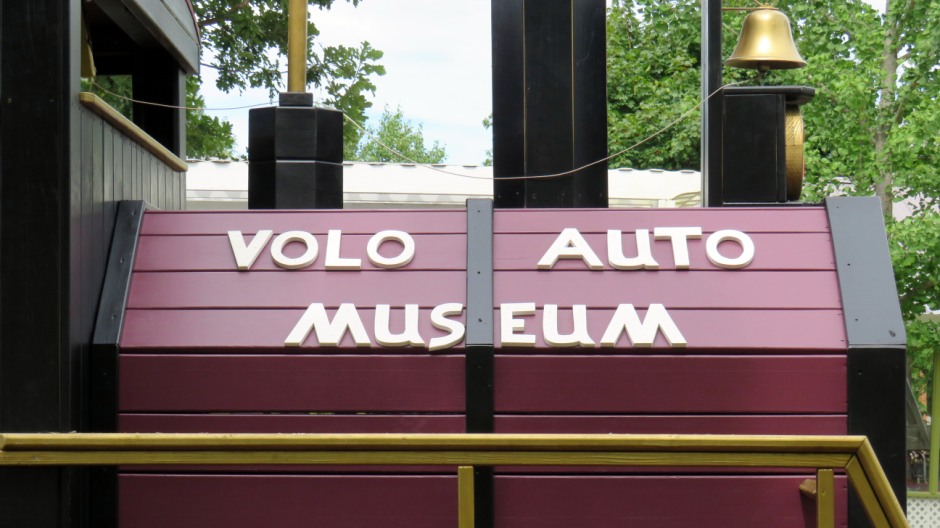
The site is in fact also an active collector’s car dealership, and more; in 1960 the Grams family purchased this property, formerly a dairy farm, with a view to living in the old farmhouse and using an old barn as a second-hand/resale shop. The family’s teenage sons Greg and Bill were interested in cars and in their spare time, away from the family business, would find old disused cars from the local area and tinker with them. Although their collection would become nothing more than a dozen or so unrestored cars, it attracted attention from people, including what would be their first customer – a man who made an offer on one of the cars, even though they weren’t being put up for sale. Recognising there was money to be made from their hobby, it was this that led the brothers to setting up their business, the “Volo Auto Museum”. Over the years and with continuous reinvestment, the business grew from a single simple barn to the multi-building site seen today, complete with fully fitted display “barns”, a cafeteria and a large antiques mall. With the successes of the business came a vast and unique collection of vehicles, attracting over a quarter of a million visitors per year, from many countries, who come here to see the museum or for the collector’s car sales.
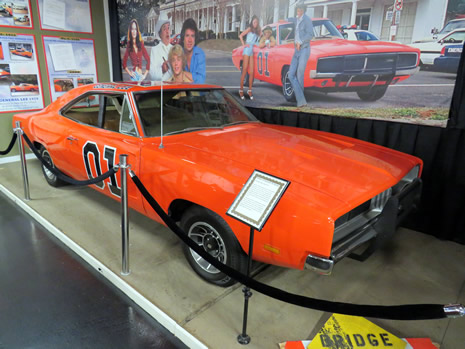 |
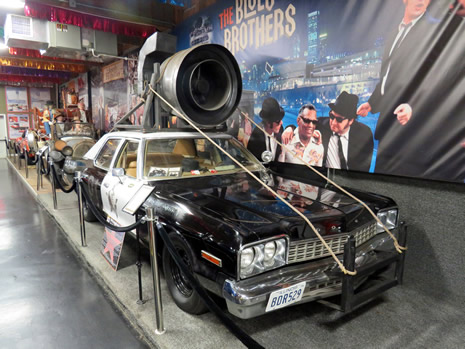 |
|
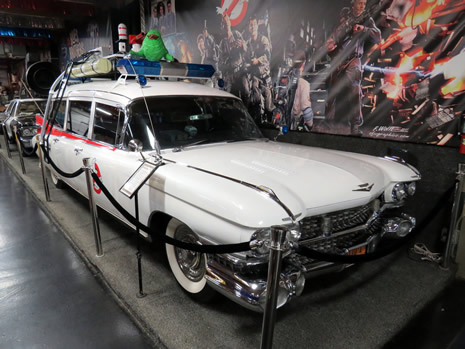 |
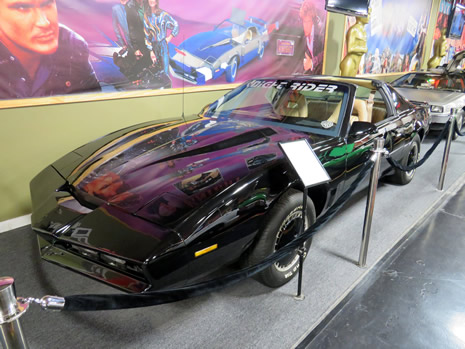 |
|
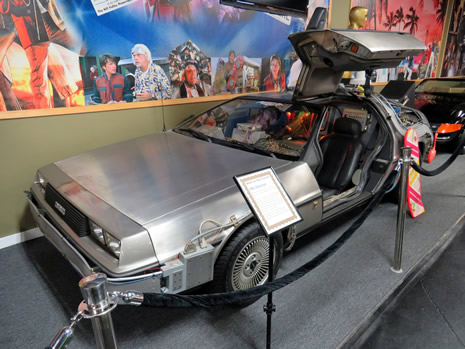 |
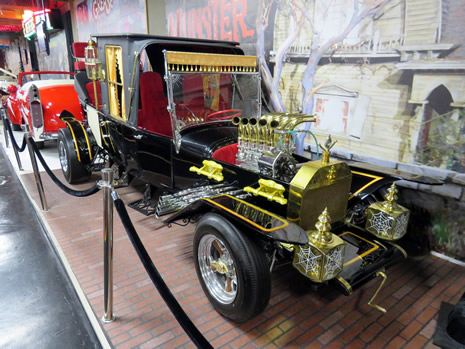 |
Over some 33 exhibits, the museum displays range from vintage to modern classics, mainly focusing on American models from the 1950’s through to the 1980’s. As well as the many vehicles that are for sale (thus making the museum very much dynamic), there is an outstanding collection of vehicles here which are for display purposes only, including vintage models, cars recognisable from TV and Hollywood films, unusual cars and models previously owned by the rich and famous. There is a large Disney and Looney Tunes characters display, an "Armed Forces Exhibit”, a Harrier Jet, an area dedicated to RV’s and transportation, a tractor exhibit, the actual lifeboat used in the 2013 film Captain Phillips and much more.
 |
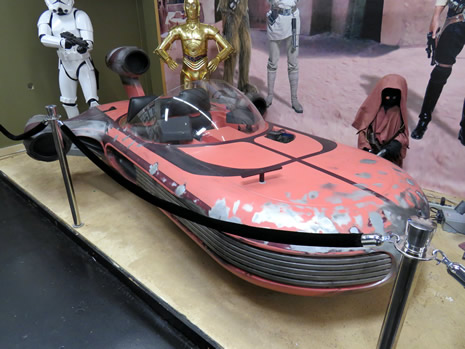 |
|
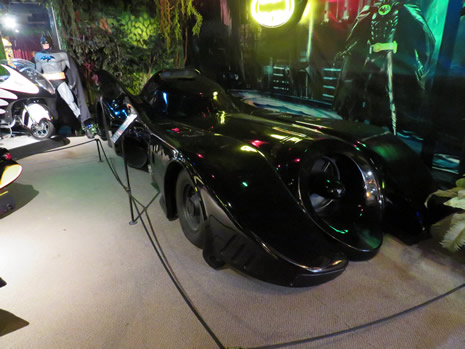 |
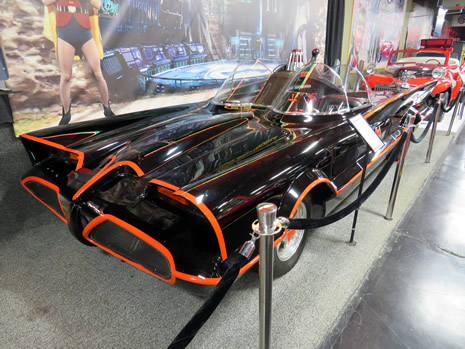 |
|
 |
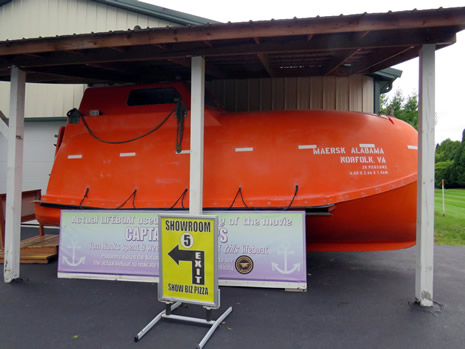 |
Cars of note on display (to name just a few) include the “General Lee” from The Dukes of Hazzard television show, “KITT” from Knight Rider, “Ecto-1” from Ghostbusters, the “Bluesmobile” from The Blues Brothers, an Aston Martin from the James Bond film Die Another Day, a Replica DeLorean from Back to the Future, The Ghost Rider motorcycle, vehicles from The Munsters, the Scooby-doo film and Batman, the original Ferrari Daytona replica driven by Don Johnson in Miami Vice, a jalopy from The Beverly Hillbillies, the “Flintstonemobile”, a Roller Skate car, a Piano car, and cars which have been owned by the likes of Michael Jordan, Rod Stewart, Oprah Winfrey, Princess Diana, Zsa Zsa Gabor and Elvis Presley. This list is far from comprehensive and for more information, the official website of the Volo Auto Museum may be found Here. The extensive thumbnail gallery below shows many of the vehicles which were on display at the time of the visit (in September 2018); click on an image to enlarge:
Whiting, Indiana
Further along the shores of Lake Michigan, about 16 miles (26km) from downtown Chicago and 2 miles (3.2km) from Chicago’s South Side is the city of Whiting, Indiana. A “lakeshore destination embracing traditional values”, the city was founded in 1889 and today has a population of approximately 5,000. The city has a theatre building and a memorial community house which are listed in the National Register of Historic Places, and visitors may be interested in the Mascot Hall of Fame which honours college and professional sports costumed characters. However, perhaps the city’s most distinguishing feature is the Whiting Refinery – the largest oil refinery in the Midwest. The latter is not exactly a tourist attraction; the primary purpose of the visit shown here was to take a stroll along the boardwalk in Whiting Lakefront Park, to see what Chicago’s city skyline looks like from a much longer way away, as viewed across the waters of Lake Michigan. Some photographs of the visit are shown in the thumbnail gallery below (click on an image to enlarge):
Gary, Indiana
Moving further into Indiana, some 25 miles (40 km) from downtown Chicago and separated only from southern Lake Michigan by railway lines and its gigantic steel mills, is the city of Gary. The city was named after lawyer Elbert Henry Gary, founding chairman of the United States Steel Corporation. Perhaps Gary’s biggest claim to fame is being the birthplace of The Jackson 5 music group.

Above: Streetart depicting The Jackson 5 in downtown Gary
It was indeed this claim to fame that a visit was made to the city, whilst passing nearby on a roadtrip, and so a beeline was made for a humble property at 2300 Jackson Street. Although there are no access or tours available, it doesn’t deter avid Jackson fans from near and far going up to see the property. The single-storey, three-room bungalow was built in 1949, along with much of Gary’s post–WWII industrial boom property and in the same year, Joe Jackson (the father of the family) made his way to Gary from Chicago to take a job at U.S. Steel. Not long after arriving here, he met his future wife, Katherine. The newly wedded couple moved into the property in January 1950. Their first child, Maureen, was born the following May and their infamous and 8th son, Michael, was born here in August, 1958. After viewing the house, a visit was made to look around the downtown area of the city. Its population is below 80,000 and less than half of what it was in 1960. This has been a result of decline in industry since this time with the demographics changing as many middle-class and white people have moved away, bringing the percentage of African-Americans here to eighty five; the once-booming steel mills here saw a decline due to overseas competition and restructuring of the industry, leaving it facing many of the difficulties faced by Rust Belt cities, which at the time of writing is one of the issues being addressed by the Trump administration. Some photographs from the visit to Gary, Indiana, are shown in the thumbnail gallery below (click on an image to enlarge):
Gary is adjacent to the Indiana Dunes National Park, which may be found on a separate page on this website Here.
Photos: September, 2018
Text: 2019
Back to Top